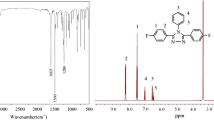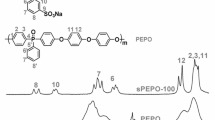Abstract
A series of new poly(1,2,4-triazole)s (PTAs) containing pyridine heterocyclic ring, bearing bulky aromatic pendent groups, were synthesized from the reaction of the corresponding polyhydrazides with aniline or 4-aminobenzenesulfonic acid in polyphosphoric acid (PPA) at 175 °C. The non-sulfonated PTAs showed glass transition temperatures (T gs) of 220–250 °C and inherent viscosities (η inh) equal to 0.48–0.78 dL/g, and the sulfonated poly(1,2,4-triazole)s (S-PTAs) exhibited T gs of 235–265 °C and inherent viscosities equal to 0.50–0.83 dL/g. The former polymers were soluble in conc. H2SO4 and partially soluble in hot N,N-dimethylformamide (DMF), dimethyl sulfoxide (DMSO), dimethylacetamide (DMAc), and 1-methyl-2-pyrrolidone (NMP), and the latter were soluble in DMF, NMP, DMSO and DMAc at room temperature. All polymers had useful levels of thermal stability and were stable up to 450 °C in nitrogen. The proton conductivities of undoped sulfonated polytriazole membranes and the acid-doped sulfonated polytriazole membranes lie in the range of 5 × 10−4–8.1 × 10−3 and 5 × 10−3–2.3 × 10−2 S/cm, respectively, at 90 °C and 100 % relative humidity.








Similar content being viewed by others
References
Cassidy PE (1980) Thermally stable polymers. Marcel Dekker, New York
Chow HF, Lau KN, Ke Z, Liang Y, Lo CM (2010) Conformational and supramolecular properties of main chain and cyclic click oligotriazoles and polytriazoles. Chem Commun 46(20):3437–3453
Xie J, Hu L, Shi W, Deng X, Cao Z, Shen Q (2008) Synthesis and nonlinear optical properties of hyperbranched polytriazole containing second-order nonlinear optical chromophore. J Polym Sci Part B Polym Phys 46:1140–1148
Tian J, Wan L, Huang J, Hu Y, Huang F, Du L (2008) Preparation and properties of a new polytriazole resin made from dialkyne and triazide compounds and its composite. Polym Bull 60:457–465
Qin A, Lam JWY, Tang L, Jim CKW, Zhao H, Sun J, Tang BZ (2009) Polytriazoles with aggregation-induced emission characteristics: synthesis by click polymerization and application as explosive chemosensors. Macromolecules 42:1421–1424
Gomes D, Roeder J, Ponce ML, Nunes SP (2007) Characterization of partially sulfonated polyoxadiazoles and oxadiazole–triazole copolymers. J Membr Sci 95:121–129
Hensema ER, Sena MER, Muldert MHV, Smolders CA (1994) Gas separation properties of new polyoxadiazole and polytriazole membranes. Gas Sep Purif 8:149–160
Janietz S, Barche J, Wedel A, Sainova D (2004) Poly(4-hexyl-1,2,4-triazole-4H): an electron semiconducting analogue to regioregular poly(hexylthiophene). Macromol Chem Phys 205:1916–1922
Lilyquist MR, Holsten JR (1967) Poly (phenylene) triazoles: new thermally stable fibers. J Polym Sci Part C 19:77–88
Gebben B, Mulder MHV, Smolders CA (1989) Gas separation properties of a thermally stable and chemically resistant polytriazole membrane. J Memb Sci 46:29–41
Gebben B, Mulder MHV, Smolders CA (1989) Thermal behavior of polytriazole films: a thermal analysis study. J Polym Sci Part A Polym Chem 27:3481–3494
Hensema ER, Sena MER, Mulder MHV, Smolders CA (1994) Syntheses and properties of related polyoxadiazoles and polytriazoles. J Polym Sci Part A Polym Chem 32:527–537
Hensema ER, Boom JP, Mulder MHV, Smolders CA (1994) Two reaction routes for the preparation of aromatic polyoxadiazoles and polytriazoles: syntheses and properties. J Polym Sci Part A Polym Chem 32:513–525
Ponce ML, Gomes D, Nunes SP (2008) One-pot synthesis of high molecular weight sulfonated poly(oxadiazole-triazole) copolymers for proton conductive membranes. J Membr Sci 319:14–22
Nanjan MJ (1985) Encyclopedia of polymer science and engineering. In: Kroschwitz JI (ed). Wiley, New York, pp 322–339
Tamami B, Yeganeh H (2002) Synthesis and properties of novel aromatic polyamides based 4-aryl-2,6-bis(4-chlorocarbonylphenyl) pyridines. Eur Polym J 38:933–940
Parvanak Boroujeni K, Tamami B, Abdulmaleki A, Osfouri S, Fadavi A (2012) Synthesis and characterization of some new aromatic polyoxadiazoles through cyclodehydration of polyhydrazides. Polym Bull 68:909–920
Li Q, Jensen JO, Savinell RF, Bjerrum NJ (2009) High temperature proton exchange membranes based on polybenzimidazoles for fuel cells. Prog Polym Sci 34:449–477
Glipa X, Haddad EL, Jones DJ, Rozière J (1997) Synthesis and characterisation of sulfonated polybenzimidazole: a highly conducting proton exchange polymer. Solid State Ionics 97:323–331
He R, Li Q, Xiao G, Bjerrum NJ (2003) Proton conductivity of phosphoric acid doped polybenzimidazole and its composites with inorganic proton conductors. J Membr Sci 226:169–184
Qing S, Huang W, Wan D (2006) Synthesis and properties of soluble sulfonated polybenzimidazoles. React Funct Polym 66:219–277
Ponce ML, Boaventura M, Gomes D, Mendes A, Madeira LM, Nunes SP (2008) Proton conducting membranes based on benzimidazole sulfonic acid doped sulfonated poly(oxadiazole-triazole) copolymer for low humidity operation. Fuel Cells 3–4:209–216
Boaventura M, Ponce ML, Brandaõ L, Mendes A, Nunes SP (2010) Proton conductive membranes based on doped sulfonated polytriazole. Int J Hydrog Energy 35:12054–12064
Gang W, Guyu X, Deyue Y (2011) Synthesis and properties of soluble sulfonated polybenzimidazoles derived from asymmetric dicarboxylic acid monomers with sulfonate group as proton exchange membrane. J Membr Sci 369:388–396
Acknowledgments
The authors are thankful to the Research Council of Shahrekord University for their partial support of this work.
Author information
Authors and Affiliations
Corresponding author
Additional information
Dedicated to the memory of Professor Ahmad Banihashemi.
Rights and permissions
About this article
Cite this article
Parvanak Boroujeni, K., Soltanian, I. & Nasrolahi Shirazi, A. Synthesis and characterization of some new aromatic polytriazoles as proton conductive membranes. Polym. Bull. 70, 2411–2422 (2013). https://doi.org/10.1007/s00289-013-0961-9
Received:
Revised:
Accepted:
Published:
Issue Date:
DOI: https://doi.org/10.1007/s00289-013-0961-9




